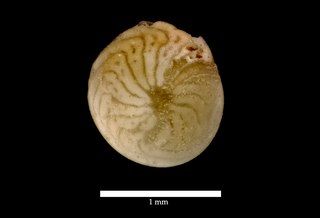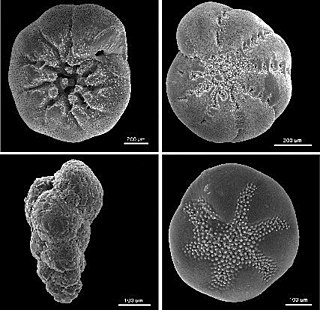
Globigerina is a genus of planktonic Foraminifera, in the order of Rotaliida. It has populated the world's oceans since the Middle Jurassic.
Rhaphischismatidae is an extinct family of fossil sea snails, marine gastropod molluscs in the superorder Vetigastropoda. They date from the Lower Carboniferous (Mississippian). The family contains a single genus, Raphischisma. In the Bouchet & Rocroi, 2005), this family is assigned to the Pleurotomariacea.

Calliotropis tiara is a species of sea snail, a marine gastropod mollusk in the family Eucyclidae.
Discorbacea, Discorboidea in recent taxonomies, is a superfamily of foraminifera,, with a range extending from the Middle Triassic to the present, characterized by chambers arranged in a low trochspiral; an umbilical or interiomarginal aperture, with or without supplementary apertures; and a wall structure that is optically radial.
Abathomphalus is a genus of foraminifera included in the Globotruncanid family.

Cibicides is a genus of cosmopolitan benthic foraminifera known from at least as far back as the Paleocene that extends down to the present.
Discorbis is a genus of benthic Foraminifera, that made its first appearance during the Eocene. Its present distribution is cosmopolitan.
Rosalina is a genus of foraminifera included in the rotaliid family Rosalinidae.
Rotorboides is a genus of recent (Holocene) bottom dwelling (benthic) forams from the Atlantic, Pacific and Indian Oceans, related to Rosalina.
Neoconorbina is a genus of recent (Holocene) discorbacean foraminifers related to Rosalina with a low conical trochoidal test, circular in outline. The conical side is the spiral side, on which all three whorls are visible, the final chamber taking up most of the periphery. The umbilical side is flat to concave. exposing only the three to four chambers of the final whorl around an open umbilicus. Chambers on the umbilical side have triangular to platelike umbilical extensions as with other rasalinids. The wall of is calcite, finely and densely perforate on the spiral side, more coarsely perforate on the umbilical side; surface smooth; aperture at the umbilical margin of the chamber, beneath the platelike extension, or folium.
Astrononion is a genus of foraminifera in the family Nonionidae, characterized by an evolute planispiral test with radially stellate structures partly covering the sutures on either side. The test is free, bilaterally symmetrical; periphery broadly rounded; chambers distinct, separated by depressed radial sutures, increasing gradually in size, and usually inflated; aperture a low arched opening at the base of the face of the test. The wall is of finely perforate monolamellar granular calcite.
Globulina is a genus of Foraminifera with an ovate to globular test, included in the Polymorphinidae, Notocariacea, that has been extant since the Middle Jurassic (Callovian).
Hedbergella is an extinct genus of planktonic foraminifera from the Cretaceous, described by Loeblich and Tappan, 1961, as:
Test free, trochospiral, biconvex, umbilicate, periphery rounded with no indication of keel or poreless margin; chambers globular to ovate; sutures depressed, radial, straight or curved; wall calcareous, finely perforate, radial in structure, surface smooth to hispid or rugose; aperture an interiomarginal, extraumbilical-umbilical arch commonly bordered above by a narrow lip or spatulate flap, ... Includes species otherwise similar to Praeglobotruncana but which lack a keel or poreless margin, hence is regarded as a separate genus rather than as a subgenus of Praeglobotruncana as by Banner and Blow (1959).
Buccella is a genus of late Cenozoic benthic foraminifera that made its first appearance during the Oligocene and is found living in recent oceans.
Halenia is a genus of recent discorbacean foraminifera. It contains only one species, Halenia legrandi The test is free, a low trochspire with a rounded periphery; wall calcareous, monolamellar. Chambers are subglobular, all visible on spiral side, only last volution visible on umbilical side; final chamber with an umbilical flap. Sutures are depressed, radial on umbilical side, curved to sinuate on spiral side, with sutural slits on both sides.
The Globoroatioidea constitutes a superfamily of Cenozoic plantonic foraminifera. It is part of the suborder Globigerinina. Globoroatioidea have trochospiral tests with rounded to carinate peripheries, the walls of which are of finely lamellar, perforate, of optically radial calcite, with an inner organic lining. The surface of these tests is smooth, lacking spines, but may be covered with pustules or pitted, and may have one or more large pores at the center. There is a single primary aperture that may be bordered by an imperforate lip, as well as possible supplementary apertures.
Gansserina is a genus of planktonic foraminifera, included in the globigerinid family Globotruncanidae, that had a fairly wide distribution in the Late Cretaceous (Maastrichtian). The type species is Gansserina gansseri.

Amphistegina is a genus of foraminiferal protists included in the Rotaliida with a stratigraphic range extending from the Eocene to recent and a cosmopolitan distribution. The test is an asymmetrically biconvex trochospiral that may be bi-involute or partially evolute on the spiral side. Chambers are numerous, broad. and low, strongly curved back at the periphery to form chamber prolongations. The umbilical side is stellate, like that of Asterigerina, and has a distinct umbilical plug. The wall is calcareous, optically radial; the surface finely perforate and smooth overall. The periphery angular to carinate (keeled); the aperture an interiomarginal slit on the umbilical side, bordered by a lip.

Foraminiferal tests are the tests of Foraminifera.
Orcadia is a monotypic genus of planktonic marine foraminifera containing the species Orcadia riedeli, which originally belonged to the genus Hastigerinella. It is found in the surface water of oceans and has a cosmopolitan distribution. The phylogenetic position of this genus remains enigmatic; it was originally assigned to the family Hastigerinidae, but was later moved to Globigerinellidae, in the order Globigerinida.




